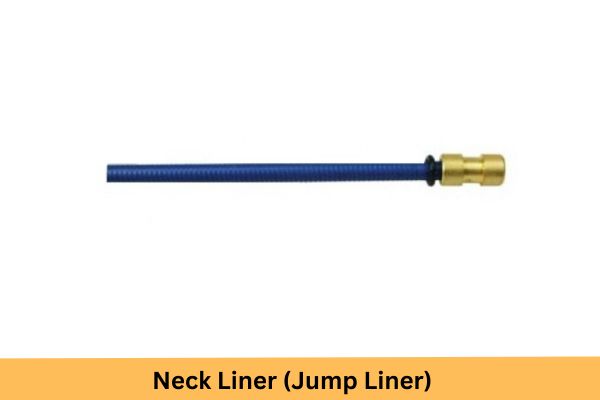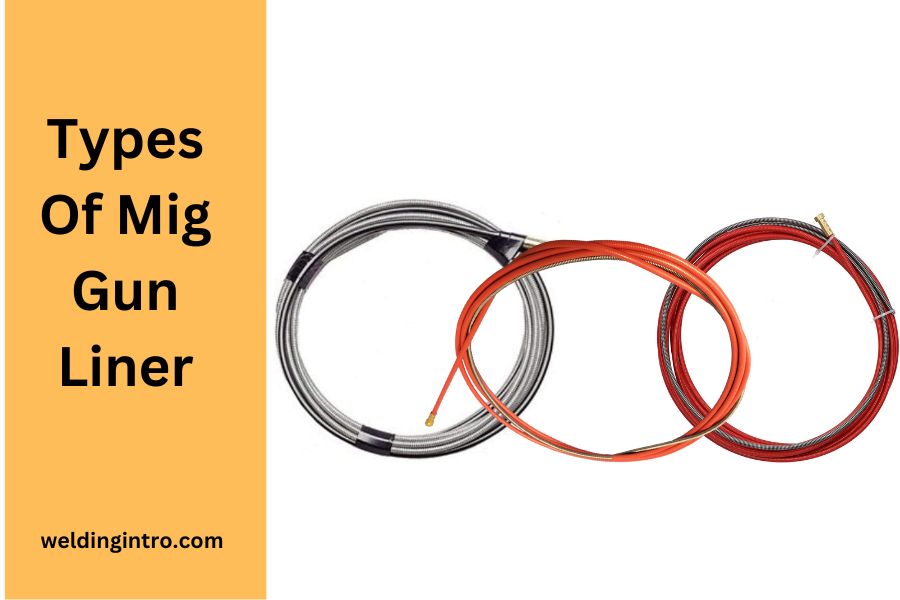A MIG gun liner is a conduit that channels the mig wire through a mig gun. The liner is shaped like a tube and it ends at the contact tip. The liner must be compatible with the size and type of mig wire. So identifying and choosing the right liner is a crucial work for perfectly welding metal pieces.
So we will categorize the types of mig gun liners in this post.
Types of Mig liner (Based On Function)
Based on usage and function, liners can be divided into another three types. They are
- front loading liners,
- spring loaded front loading liners and
- conventional liners.
In this section, we will discuss the liners.
1. Conventional Liners

Conventional liners are liners either made of steel or plastic and do the typical liners job. The design of a conventional MIG gun liner is straightforward, aiming to provide a clear and unobstructed path for the welding wire.
Welders can use different wire types based on the specific requirements of the welding application as it is compatible with any wire. They are typically designed for easy replacement when necessary.
Front Loading Liners

Front loading liners are designed to make liner replacement quick and easy. These liners have a split outer casing that allows the liner to be loaded from the front of the MIG gun.
This design eliminates the need to disassemble the MIG gun to replace the liner. Front loading liners are available in various sizes and lengths to fit different MIG gun models.
Spring Loaded Front Loading Liners
Spring loaded front loading liners are an improvement over the standard front loading liners. These liners have a spring-loaded mechanism that keeps the liner in place and prevents it from slipping out of the MIG gun during use.
The spring-loaded mechanism also ensures that the liner is correctly aligned with the contact tip, which helps to reduce wire feeder issues. Spring loaded front loading liners are available in various sizes and lengths to fit different MIG gun models.
Types Of Liner Based On Material
Based on material, mig liners can be classified into three types. They are-
1. Steel Mig Gun Liner

Steel Liners are the most common type of liner used in MIG welding. They are made of high carbon steel and are highly durable. If you want rigidity, flexibility and best performance, then go for steel liners.
They are popular worldwide to the mig welders. Most steel liners are compatible with mild steel welding wire. If you don’t use the right liner then mig welding problems would arise.
Two special features of a steel liners is its abrasiveness and resistance to contamination in case of using softer materials like aluminum and bronze wire. They are also resistant to high temperatures and are less likely to kink or twist during use.
So you should use steel liner with any softer mig wire. If your filler metal is softer, then you should ignore steel liner as it may cause contamination.
There are two types of steel liners. One is a normal steel liner and another one is an insulated steel liner. Mig gas supply to the gun is the determinant for which liner to use.
For example, if you are using gas that is channeled to the gun through a dedicated gas line, then using a regular steel liner would do the job. It won’t cause any issues anyway. But if you are using gas supplied to a gun through a gun cable around a wire liner, then you should go for an insulated steel liner.
The proper insulation of the MIG torch liner surrounding the collet prevents gas leakage through the coils, ensuring that it does not purge out from the rear of the MIG gun.
Check the manufacturer guide first to be sure of the right liner to use in your projects.
2. Plastic Liners

Plastic MIG Gun Liners are made of high-density polyethylene (HDPE) and are known for their flexibility and ease of use. They are ideal for welding softer materials such as aluminum and are less likely to scratch the wire, leading to a smoother feed.
The functions are the same as steel liners but differ in installation process, usage and material. They are compatible with certain types of filler metal and for specific projects these liners are used.
However, plastic liners are not as durable as steel liners and tend to wear out faster, requiring frequent replacements.
Following are a few plastic liners that can assist in high quality mig weld.
- For various types of Mig wire, Polyamide liners are best used. They are actually nylon liners filled with carbon and are designed for use in low temperature applications. It is cheaper than steel liners and suitable for welding smaller gauges metals like aluminum, bronze-silicon and stainless steel.
- Combi-PA liner is a type of liner that is best for welding higher temperature applications. It is basically a short brass spiral wound liner that transfers current flow to the wire precisely making a good quality weld. It is a good choice to work with aluminum, silicone bronze wires. It can work at higher duty cycle applications smoothly as it has a higher melting point compared to the softer mig wires being used in welding.
- Polyethylene is a material that is used in projects requiring more stability and smoothness. Polyethylene mig liners perform better with soft mig wires like aluminum bronze and 4xxx aluminum series. For stable wire feeding, this liner is best suited. Also its melting point is lower than mig wire that facilitates low heat applications.
- Teflon (PTFE) has a higher melting point than polyethylene and is best for welding high heat applications. Their abrasion resistance is better and they can be used with various types of wire. Make sure you carefully inspect the insertion of the wire into the liner. Otherwise, it may cause premature wear of mig wire. PTFE is friendly with water-cooling torches.

- Carbon Teflon (C-PTFE) is a variation of Teflon liner that is impregnated with carbon. Its best temperature resistance makes it adorable compared to other plastic liners. You can use it with wires that are critical to feed for softer compositions like stainless steel ER308, ER309, ER409C etc. Moreover, it works just fine with ER5356 and such kinds of aluminum as well.
- Last but certainly not least, this one is so popular among pro welders for its extended service life. High density Teflon is another variation of Teflon liner, famous for its high molecular weight. It offers the same melting point as carbon Teflon liner and is popular for its longer life. It works with any type of wire ranging from softer to stiffer or even abrasive.
3. Neck Liners

Neck liners, also known as Jump Liners, are compact liners with a small collet that are situated in the welding torch swan neck. It offers a simpler replacement process in the event of liner failure. It is used as a supplement to the main liner to enhance the lifespan of both wire and liner.
The primary area of MIG liner failure typically occurs at the bend of the gun’s neck. So using a neck liner not only saves time but also reduces the cost associated with replacement of new liner.
Neck liners are suitable for both robotic and manual welding applications. Similar to selecting the appropriate wire liner, it is crucial to match the size of the neck liner to the wire being used.
Innovations in MIG Gun Liners
In recent years, there have been several innovations in liners. One of the most significant innovations is the development of liner materials that are more wear-resistant and durable. These liners are made from materials such as tungsten carbide, which can withstand high temperatures and abrasive materials.
Another innovation is the development of liners that can be friction welded. Friction welding allows tubular liner sections to be welded together, which enables the use of different materials in critical areas of wear, erosion, and fatigue.
This innovation has resulted in liners that last longer and require less frequent replacement.
What are the key factors to consider when selecting MIG gun consumables, including liners?
When selecting MIG gun consumables, including liners, there are several key factors to consider. These include
- the type of welding application,
- the type of welding wire being used,
- the diameter of the wire, and
- the type of gas being used.
It is important to choose the correct liner for your specific application to ensure optimal performance and prevent damage to the welding wire. Additionally, selecting high-quality consumables can help to reduce downtime and increase productivity.
Frequently Asked Questions
1. What are the differences between MIG gun liners for aluminum and steel?
MIG liners for aluminum and steel differ in their material composition, diameter, and length. Aluminum MIG gun liners are made of softer materials like nylon or Teflon to reduce friction and prevent wire feeding problems.
Steel liners, on the other hand, are made of harder materials like steel or brass to withstand the wire’s abrasive nature. The diameter and length of the MIG torch liners vary depending on the wire’s size and type used for welding aluminum or steel.
2. How do I identify when to replace my MIG gun liner?
You can do that by examining the wire feeding performance. If the wire is wandering or drifting within the liner, it indicates that the liner is worn out or damaged.
Similarly, if the wire is feeding erratically or experiencing wire jamming issues, it may be time to replace the MIG torch liner.
3. What are the advantages of using a Teflon MIG gun liner?
The primary advantage of using a Teflon liner is its low friction coefficient, which reduces wire feeding problems and improves the welding quality.
Teflon liners are particularly useful when welding soft materials like aluminum or when using softer wires like flux-cored wires.
Additionally, Teflon liners are easy to clean and maintain, making them a popular choice for many welders.
4. Can a nylon MIG gun liner be used for any welding applications?
Nylon liners are suitable for welding applications that require low-heat and low-amperage settings. They are ideal for welding soft materials like aluminum and are compatible with a wide range of wires, including flux-cored wires.
However, nylon liners may not be suitable for high-heat or high-amperage welding applications, as they have a lower melting point than other liner materials.
5. What are the signs indicating a bad MIG gun liner?
Some signs indicating a bad MIG gun liner include wire feeding problems, erratic wire feeding, wire jamming, and excessive liner wear. Welders should inspect their MIG liners regularly and replace them as needed to maintain optimal welding performance.
6. How does one choose the appropriate MIG gun liner for different wire types?
To choose an appropriate MIG liner for different wire types, one must consider the wire’s diameter and material type. Welders should select liners that are compatible with their wire size and material to prevent wire feeding problems and improve welding quality.
Additionally, welders may choose liners made of different materials, such as Teflon or steel, depending
Lastly
In conclusion, MIG gun liners are an essential component of the MIG welding process. Every type of mig liner is essential for different types of projects and materials.
Front loading liners and spring loaded front loading liners are designed to make liner replacement quick and easy, while new liner materials and friction welding have resulted in more durable and wear-resistant liners.
